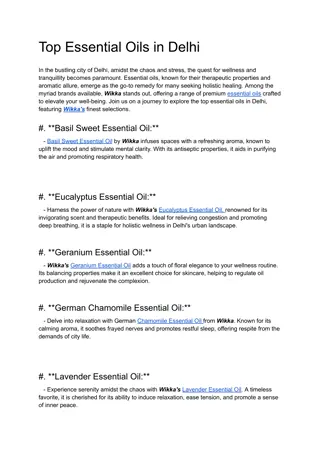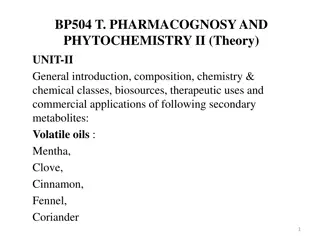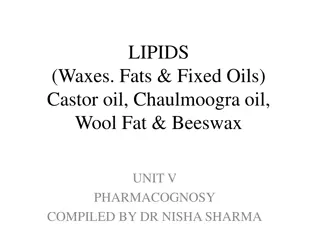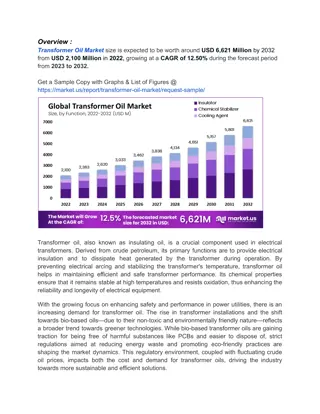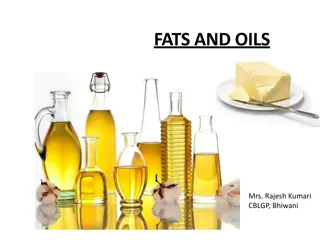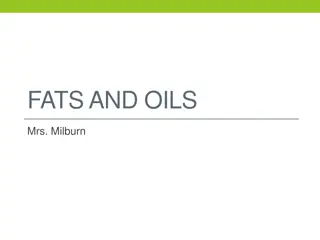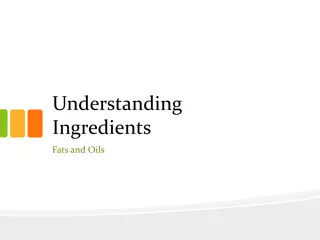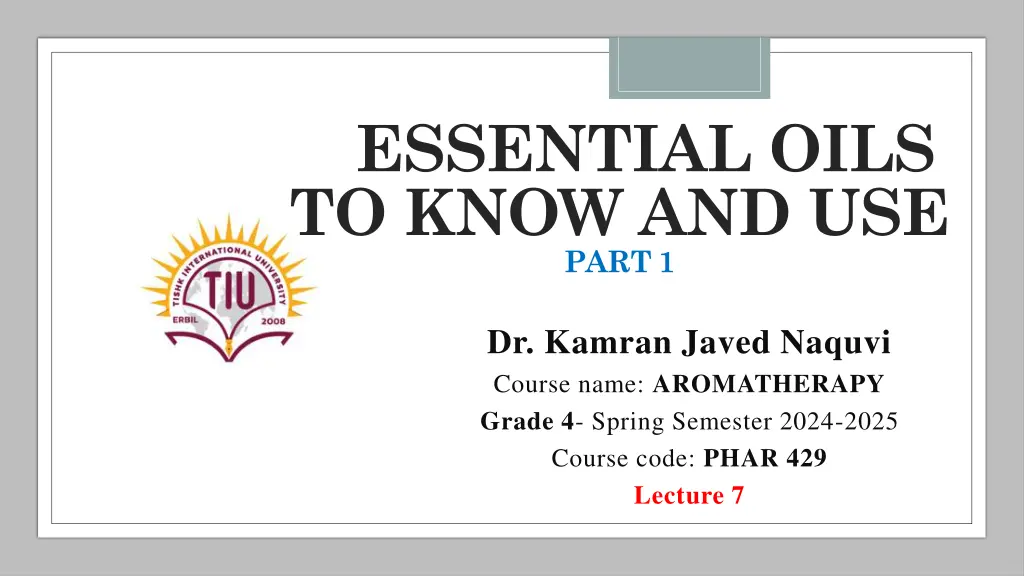
Aromatherapy Essential Oils: Mandarin and Basil - Properties and Uses
Discover the rich properties and versatile uses of Mandarin and Basil essential oils in aromatherapy, skincare, digestive health, perfumery, and household cleaning. Explore their chemical constituents and benefits for relaxation, skin toning, stress relief, and antimicrobial purposes. Enhance your holistic well-being with these valuable natural remedies.
Download Presentation

Please find below an Image/Link to download the presentation.
The content on the website is provided AS IS for your information and personal use only. It may not be sold, licensed, or shared on other websites without obtaining consent from the author. If you encounter any issues during the download, it is possible that the publisher has removed the file from their server.
You are allowed to download the files provided on this website for personal or commercial use, subject to the condition that they are used lawfully. All files are the property of their respective owners.
The content on the website is provided AS IS for your information and personal use only. It may not be sold, licensed, or shared on other websites without obtaining consent from the author.
E N D
Presentation Transcript
ESSENTIAL OILS TO KNOW AND USE PART 1 Dr. Kamran Javed Naquvi Course name: AROMATHERAPY Grade 4- Spring Semester 2024-2025 Course code: PHAR 429 Lecture 7
Mandarin Oil Mandarin oil is derived from the peel of the mandarin fruit (Citrus reticulata) through a process known as cold-press extraction. Mandarin oil is extracted from the outer peel of the mandarin fruit, which is a small citrus fruit closely related to oranges. Mandarin trees are native to China, and cultivated in South China, Japan, and Vietnam. Family Rutaceae 2
Chemical Constituents Limonene: 65-75%, A Major component in citrus oils, known for its uplifting and stimulating properties. -Terpinene: 10-15%, Another common constituent in citrus oils with antimicrobial properties. -Pinene: 1-5%, Known for its anti-inflammatory and bronchodilator properties. Citral: 0.5-1.5%, Imparts a citrusy aroma and has antimicrobial properties. Linalool: 0.1-0.5%, Has calming and sedative effects, contributing to the oil's relaxing properties. -Pinene, Sabinene, Myrcene, -Terpinolene, Geranial, Neral, Terpineol. 3
Uses Aromatherapy: It is widely used in aromatherapy for its uplifting, calming, and mood-enhancing properties. It is used to reduce stress and anxiety and, promote relaxation. Skincare: Mandarin oil is used in skincare products for its astringent/antimicrobial properties, which help to tone and restore the skin. It's also beneficial for oily and acne-prone skin due to its antiseptic properties. Digestive Aid: It can be added to massage blends or diluted in a carrier oil and applied to the abdomen to relieve digestive discomfort. Perfumery: Mandarin oil is a popular ingredient in perfumery due to its fresh, fruity aroma. It adds a bright, citrusy note to fragrances and blends well with other essential oils. Household Cleaners: Due to its antimicrobial properties, mandarin oil can be added to natural household cleaners to help disinfect surfaces 4
Basil oil Biological Source: Basil oil is derived from the Ocimum basilicumplant, commonly known as holy basil. This aromatic herb belongs to the Lamiaceae (mint) family and is native to tropical regions of Asia and Africa. Basil is cultivated worldwide for its culinary uses as well as for its medicinal and aromatic properties. 5
Chemical constituents Methyl chavicol (Estragole): 60-85%, Provides basil oil with its characteristic aroma and is believed to have antimicrobial properties. Linalool: 10-25%, Known for its calming and sedative effects. Eugenol: 1-10%, Exhibits antimicrobial properties. analgesic (pain-relieving) and Estragole 1,8-Cineole (Eucalyptol): 1-10%, Possesses expectorant and anti- inflammatory properties. -Caryophyllene: Known for its anti-inflammatory and analgesic effects. Camphor: Exhibits antiseptic and cooling properties. Eugenol 6
Uses Culinary: Basil oil is commonly used as a flavoring agent in cooking, particularly in Mediterranean and Asian cuisines. such as pasta sauces, salads, and soups. Aromatherapy: Basil oil is valued in aromatherapy for its uplifting, clarifying, and energizing properties. Basil oil is often included in blends designed to relieve stress and anxiety. Massage: Diluted basil oil can be used in massage blends to relieve muscle tension and promote relaxation. Its analgesic properties make it beneficial for soothing sore muscles and joints. Skin Care: Basil oil is sometimes used in skincare products for its antiseptic and antibacterial properties. It may help to cleanse and purify the skin, making it suitable for oily or acne-prone skin. Hair Care: Basil oil is believed to promote scalp health and stimulate hair growth. 7
Eucalyptus Oil Eucalyptus oil is extracted from the leaves of various species of eucalyptus trees, primarily Eucalyptus globulus These trees are native to Australia but are now cultivated in China, Brazil, and India. The Eucalyptus genus belongs to the family Myrtaceae, commonly known as the myrtle family. 8
Chemical Constituents 1,8-Cineole (Eucalyptol): 60-90%, Typically the dominant constituent, providing eucalyptus oil with its characteristic aroma and therapeutic properties. It has expectorant, anti-inflammatory, and antimicrobial properties. -Pinene: 5-15%, Exhibits anti-inflammatory, bronchodilator, and antimicrobial effects. Limonene: 1-10%, Known for its uplifting and mood-enhancing properties. p-Cymene: Possesses antioxidant and antimicrobial properties. Globulol: Contributes to the oil's antimicrobial and anti-inflammatory effects. Terpinen-4-ol: Exhibits antimicrobial and immune-stimulating properties. -Terpineol: Known for its calming and sedative effects. 9
Uses Respiratory Health: Eucalyptus oil is commonly used to relieve respiratory symptoms such as congestion, coughs, and sinusitis. Its expectorant and decongestant properties help to clear the airways and promote easier breathing. Antimicrobial: Eucalyptus oil exhibits strong antimicrobial activity against bacteria, viruses, and fungi. Pain Relief: The oil's anti-inflammatory and analgesic properties make it beneficial for relieving muscle and joint pain, arthritis, and headaches. It can be applied topically or used in massage blends. Insect Repellent: Eucalyptus oil is effective at repelling insects such as mosquitoes and ticks. Household Cleaning: Due to its antimicrobial properties, eucalyptus oil is used in natural household cleaners to disinfect surfaces and freshen the air. 10
Ginger oil Biological Source: Ginger oil is derived from the rhizomes of Zingiber officinale. Ginger is a flowering plant native to Southeast Asia but is now cultivated in many tropical and subtropical regions worldwide. The rhizome of the ginger plant is harvested, cleaned, dried, and then steam distilled to extract the essential oil. Family Zingiberaceae China is the Biggest exporter of ginger and USA is the biggest importer 11
Chemical Constituents: Zingiberene: Provides ginger oil with its characteristic spicy aroma. Gingerol: Gingerol is responsible for the characteristic spicy and pungent taste of ginger. This primary bioactive compound in ginger is responsible for its anti-inflammatory and antioxidant properties. Shogaol: Formed from gingerol during the drying or cooking process, shogaol also possesses anti-inflammatory and antioxidant properties. -Sesquiphellandrene, -Bisabolene, -Zingiberene 12
Uses Digestive Aid: Ginger oil is well-known for its digestive benefits. It stimulates digestion and promotes the secretion of digestive enzymes. It can be used to treat nausea, indigestion, bloating, and stomach discomfort. Anti-inflammatory: Ginger oil helps to reduce inflammation and pain associated with arthritis, muscle soreness, and migraines. Immune Support: Ginger oil has immune-boosting properties due to its antioxidant content. It may help strengthen the immune system and protect against infections. Nausea Relief: It can be inhaled directly from the bottle or applied to the skin (when properly diluted) to help relieve symptoms. Pain Management: It has warming properties that help improve circulation and reduce discomfort. Ginger oil can be used topically to relieve pain. 13
Cinnamon oil Biological Source: Cinnamon oil is extracted from the bark of Cinnamomum zeylanicum, commonly known as Ceylon cinnamon or true cinnamon, or Cinnamomum cassia (Chinese cinnamon), which are evergreen trees belonging to the Lauraceae family. Cinnamomum zeylanicum is native to Sri Lanka (formerly known as Ceylon), but it is also cultivated in other parts of the world with suitable climates, including India, Madagascar, and the Caribbean. Quilled shape Bark 14
Chemical Constituents Cinnamaldehyde: The primary component responsible for the characteristic aroma and flavor of cinnamon. It also possesses antimicrobial and anti-inflammatory properties. Eugenol: Another key compound found in cinnamon oil, known for its analgesic, antimicrobial, and antioxidant properties. Linalool: Contributes to the oil's aroma and has calming and sedative effects. -Caryophyllene: Exhibits anti-inflammatory properties. Benzyl benzoate: Provides a sweet, balsamic aroma and may have insecticidal properties. and analgesic 15
Uses 1.Aromatherapy: Cinnamon oil is valued in aromatherapy for its warming, comforting, and stimulating properties. It can help alleviate stress, fatigue, and mental exhaustion, and uplift the mood. 2.Digestive Aid: Cinnamon oil is believed to aid digestion by stimulating the secretion of digestive enzymes. 3.Antimicrobial: Cinnamon oil exhibits strong antimicrobial properties, making it effective against bacteria, viruses, and fungi. It can be used in natural cleaning products, mouthwashes, and topical preparations to prevent infections. 4.Pain Relief: The analgesic properties of cinnamon oil make it beneficial for relieving muscle and joint pain. It can be diluted in carrier oil and applied topically to sore areas. 5.Air Freshener: Cinnamon oil's warm and spicy aroma makes it a popular choice for natural air fresheners and diffuser blends, particularly during the colder months. 16
Nutmeg Oil Nutmeg oil is extracted from the seeds of the scientifically known as Myristica fragrans. nutmeg tree, This evergreen tree belongs to the Myristicaceae family and is native to the Moluccas (Spice Islands) of Indonesia. Nutmeg trees are also cultivated in other tropical regions, including India, Sri Lanka, and the Caribbean. 17
Chemical Constituents Myristicin: This is responsible for nutmeg oil's characteristic aroma and flavor. It also possesses psychoactive properties in high doses. Elemicin: Found in smaller quantities, elemicin adds to the aromatic profile of nutmeg oil and may have psychoactive effects similar to myristicin. Eugenol: Another aromatic compound found in nutmeg oil, which contributes to its spicy and warm aroma. Eugenol also exhibits antimicrobial and analgesic properties. -Pinene: Contributes to nutmeg oil's aroma and has potential anti-inflammatory and bronchodilator properties. Sabinene: Another monoterpene found in nutmeg oil, which may have antioxidant and antimicrobial effects 18
Uses Culinary: Nutmeg oil is commonly used as a flavoring agent in cooking and baking. It adds a warm, spicy, and slightly sweet flavor. Nutmeg is also used in the preparation of spice blends like garam masala and pumpkin pie spice. Digestive Aid: Nutmeg oil is believed to aid digestion and relieve digestive discomfort such as indigestion, bloating, and gas. Pain Relief: Nutmeg oil has analgesic properties and may help relieve muscle pain, joint pain, headaches, and menstrual cramps. Aromatherapy: In aromatherapy, nutmeg oil is valued for its warm, spicy, and comforting aroma. It can help alleviate stress, anxiety, and mental fatigue, promote relaxation, and uplift the mood when diffused or inhaled. 19
References Evans, W. C. (2009). Trease and Evans' Pharmacognosy. Elsevier Health Sciences. Price S, Price L. Aromatherapy for health professionals. 4th Edn., London: Churchill Livingstone; 2011. Lis-Balchin M. Aromatherapy Science: A guide for healthcare professionals. London: Pharmaceutical Press; 2006 20
Thank You 21

